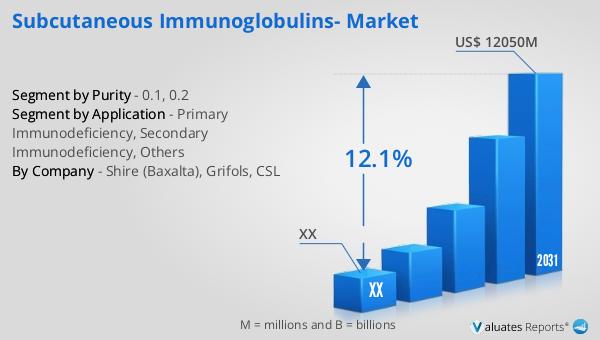List of Tables
Table 1. Subcutaneous Immunoglobulins Market Trends
Table 2. Subcutaneous Immunoglobulins Market Drivers & Opportunity
Table 3. Subcutaneous Immunoglobulins Market Challenges
Table 4. Subcutaneous Immunoglobulins Market Restraints
Table 5. Global Subcutaneous Immunoglobulins Revenue by Company (2020-2025) & (US$ Million)
Table 6. Global Subcutaneous Immunoglobulins Revenue Market Share by Company (2020-2025)
Table 7. Global Subcutaneous Immunoglobulins Sales Volume by Company (2020-2025) & (K Bottle)
Table 8. Global Subcutaneous Immunoglobulins Sales Volume Market Share by Company (2020-2025)
Table 9. Global Market Subcutaneous Immunoglobulins Price by Company (2020-2025) & (USD/Bottle)
Table 10. Key Manufacturers Subcutaneous Immunoglobulins Manufacturing Base and Headquarters
Table 11. Key Manufacturers Subcutaneous Immunoglobulins Product Type
Table 12. Key Manufacturers Time to Begin Mass Production of Subcutaneous Immunoglobulins
Table 13. Global Subcutaneous Immunoglobulins Manufacturers Market Concentration Ratio (CR5 and HHI)
Table 14. Global Top Manufacturers Market Share by Company Type (Tier 1, Tier 2, and Tier 3) & (based on the Revenue in Subcutaneous Immunoglobulins as of 2024)
Table 15. Mergers & Acquisitions, Expansion Plans
Table 16. Global Subcutaneous Immunoglobulins Sales Value by Purity: 2020 VS 2024 VS 2031 (US$ Million)
Table 17. Global Subcutaneous Immunoglobulins Sales Value by Purity (2020-2025) & (US$ Million)
Table 18. Global Subcutaneous Immunoglobulins Sales Value by Purity (2026-2031) & (US$ Million)
Table 19. Global Subcutaneous Immunoglobulins Sales Market Share in Value by Purity (2020-2025)
Table 20. Global Subcutaneous Immunoglobulins Sales Market Share in Value by Purity (2026-2031)
Table 21. Global Subcutaneous Immunoglobulins Sales Volume by Purity: 2020 VS 2024 VS 2031 (K Bottle)
Table 22. Global Subcutaneous Immunoglobulins Sales Volume by Purity (2020-2025) & (K Bottle)
Table 23. Global Subcutaneous Immunoglobulins Sales Volume by Purity (2026-2031) & (K Bottle)
Table 24. Global Subcutaneous Immunoglobulins Sales Market Share in Volume by Purity (2020-2025)
Table 25. Global Subcutaneous Immunoglobulins Sales Market Share in Volume by Purity (2026-2031)
Table 26. Global Subcutaneous Immunoglobulins Price by Purity (2020-2025) & (USD/Bottle)
Table 27. Global Subcutaneous Immunoglobulins Price by Purity (2026-2031) & (USD/Bottle)
Table 28. Global Subcutaneous Immunoglobulins Sales Value by Application: 2020 VS 2024 VS 2031 (US$ Million)
Table 29. Global Subcutaneous Immunoglobulins Sales Value by Application (2020-2025) & (US$ Million)
Table 30. Global Subcutaneous Immunoglobulins Sales Value by Application (2026-2031) & (US$ Million)
Table 31. Global Subcutaneous Immunoglobulins Sales Market Share in Value by Application (2020-2025)
Table 32. Global Subcutaneous Immunoglobulins Sales Market Share in Value by Application (2026-2031)
Table 33. Global Subcutaneous Immunoglobulins Sales Volume by Application: 2020 VS 2024 VS 2031 (K Bottle)
Table 34. Global Subcutaneous Immunoglobulins Sales Volume by Application (2020-2025) & (K Bottle)
Table 35. Global Subcutaneous Immunoglobulins Sales Volume by Application (2026-2031) & (K Bottle)
Table 36. Global Subcutaneous Immunoglobulins Sales Market Share in Volume by Application (2020-2025)
Table 37. Global Subcutaneous Immunoglobulins Sales Market Share in Volume by Application (2026-2031)
Table 38. Global Subcutaneous Immunoglobulins Price by Application (2020-2025) & (USD/Bottle)
Table 39. Global Subcutaneous Immunoglobulins Price by Application (2026-2031) & (USD/Bottle)
Table 40. Global Subcutaneous Immunoglobulins Sales Value by Region, (2020 VS 2024 VS 2031) & (US$ Million)
Table 41. Global Subcutaneous Immunoglobulins Sales Value by Region (2020-2025) & (US$ Million)
Table 42. Global Subcutaneous Immunoglobulins Sales Value by Region (2026-2031) & (US$ Million)
Table 43. Global Subcutaneous Immunoglobulins Sales Value by Region (2020-2025) & (%)
Table 44. Global Subcutaneous Immunoglobulins Sales Value by Region (2026-2031) & (%)
Table 45. Global Subcutaneous Immunoglobulins Sales Volume by Region (K Bottle): 2020 VS 2024 VS 2031
Table 46. Global Subcutaneous Immunoglobulins Sales Volume by Region (2020-2025) & (K Bottle)
Table 47. Global Subcutaneous Immunoglobulins Sales Volume by Region (2026-2031) & (K Bottle)
Table 48. Global Subcutaneous Immunoglobulins Sales Volume by Region (2020-2025) & (%)
Table 49. Global Subcutaneous Immunoglobulins Sales Volume by Region (2026-2031) & (%)
Table 50. Global Subcutaneous Immunoglobulins Average Price by Region (2020-2025) & (USD/Bottle)
Table 51. Global Subcutaneous Immunoglobulins Average Price by Region (2026-2031) & (USD/Bottle)
Table 52. Key Countries/Regions Subcutaneous Immunoglobulins Sales Value Growth Trends, (US$ Million): 2020 VS 2024 VS 2031
Table 53. Key Countries/Regions Subcutaneous Immunoglobulins Sales Value, (2020-2025) & (US$ Million)
Table 54. Key Countries/Regions Subcutaneous Immunoglobulins Sales Value, (2026-2031) & (US$ Million)
Table 55. Key Countries/Regions Subcutaneous Immunoglobulins Sales Volume, (2020-2025) & (K Bottle)
Table 56. Key Countries/Regions Subcutaneous Immunoglobulins Sales Volume, (2026-2031) & (K Bottle)
Table 57. Shire (Baxalta) Company Information
Table 58. Shire (Baxalta) Introduction and Business Overview
Table 59. Shire (Baxalta) Subcutaneous Immunoglobulins Sales (K Bottle), Revenue (US$ Million), Price (USD/Bottle) and Gross Margin (2020-2025)
Table 60. Shire (Baxalta) Subcutaneous Immunoglobulins Product Offerings
Table 61. Shire (Baxalta) Recent Development
Table 62. Grifols Company Information
Table 63. Grifols Introduction and Business Overview
Table 64. Grifols Subcutaneous Immunoglobulins Sales (K Bottle), Revenue (US$ Million), Price (USD/Bottle) and Gross Margin (2020-2025)
Table 65. Grifols Subcutaneous Immunoglobulins Product Offerings
Table 66. Grifols Recent Development
Table 67. CSL Company Information
Table 68. CSL Introduction and Business Overview
Table 69. CSL Subcutaneous Immunoglobulins Sales (K Bottle), Revenue (US$ Million), Price (USD/Bottle) and Gross Margin (2020-2025)
Table 70. CSL Subcutaneous Immunoglobulins Product Offerings
Table 71. CSL Recent Development
Table 72. Key Raw Materials Lists
Table 73. Raw Materials Key Suppliers Lists
Table 74. Subcutaneous Immunoglobulins Downstream Customers
Table 75. Subcutaneous Immunoglobulins Distributors List
Table 76. Research Programs/Design for This Report
Table 77. Key Data Information from Secondary Sources
Table 78. Key Data Information from Primary Sources
List of Figures
Figure 1. Subcutaneous Immunoglobulins Product Picture
Figure 2. Global Subcutaneous Immunoglobulins Sales Value, 2020 VS 2024 VS 2031 (US$ Million)
Figure 3. Global Subcutaneous Immunoglobulins Sales Value (2020-2031) & (US$ Million)
Figure 4. Global Subcutaneous Immunoglobulins Sales Volume (2020-2031) & (K Bottle)
Figure 5. Global Subcutaneous Immunoglobulins Sales Price (2020-2031) & (USD/Bottle)
Figure 6. Subcutaneous Immunoglobulins Report Years Considered
Figure 7. Global Subcutaneous Immunoglobulins Players Revenue Ranking (2024) & (US$ Million)
Figure 8. Global Subcutaneous Immunoglobulins Players Sales Volume Ranking (2024) & (K Bottle)
Figure 9. The 5 and 10 Largest Manufacturers in the World: Market Share by Subcutaneous Immunoglobulins Revenue in 2024
Figure 10. Subcutaneous Immunoglobulins Market Share by Company Type (Tier 1, Tier 2, and Tier 3): 2020 VS 2024
Figure 11. 0.1 Picture
Figure 12. 0.2 Picture
Figure 13. Global Subcutaneous Immunoglobulins Sales Value by Purity (2020 VS 2024 VS 2031) & (US$ Million)
Figure 14. Global Subcutaneous Immunoglobulins Sales Value Market Share by Purity, 2024 & 2031
Figure 15. Global Subcutaneous Immunoglobulins Sales Volume by Purity (2020 VS 2024 VS 2031) & (K Bottle)
Figure 16. Global Subcutaneous Immunoglobulins Sales Volume Market Share by Purity, 2024 & 2031
Figure 17. Global Subcutaneous Immunoglobulins Price by Purity (2020-2031) & (USD/Bottle)
Figure 18. Product Picture of Primary Immunodeficiency
Figure 19. Product Picture of Secondary Immunodeficiency
Figure 20. Product Picture of Others
Figure 21. Global Subcutaneous Immunoglobulins Sales Value by Application (2020 VS 2024 VS 2031) & (US$ Million)
Figure 22. Global Subcutaneous Immunoglobulins Sales Value Market Share by Application, 2024 & 2031
Figure 23. Global Subcutaneous Immunoglobulins Sales Volume by Application (2020 VS 2024 VS 2031) & (K Bottle)
Figure 24. Global Subcutaneous Immunoglobulins Sales Volume Market Share by Application, 2024 & 2031
Figure 25. Global Subcutaneous Immunoglobulins Price by Application (2020-2031) & (USD/Bottle)
Figure 26. North America Subcutaneous Immunoglobulins Sales Value (2020-2031) & (US$ Million)
Figure 27. North America Subcutaneous Immunoglobulins Sales Value by Country (%), 2024 VS 2031
Figure 28. Europe Subcutaneous Immunoglobulins Sales Value, (2020-2031) & (US$ Million)
Figure 29. Europe Subcutaneous Immunoglobulins Sales Value by Country (%), 2024 VS 2031
Figure 30. Asia Pacific Subcutaneous Immunoglobulins Sales Value, (2020-2031) & (US$ Million)
Figure 31. Asia Pacific Subcutaneous Immunoglobulins Sales Value by Region (%), 2024 VS 2031
Figure 32. South America Subcutaneous Immunoglobulins Sales Value, (2020-2031) & (US$ Million)
Figure 33. South America Subcutaneous Immunoglobulins Sales Value by Country (%), 2024 VS 2031
Figure 34. Middle East & Africa Subcutaneous Immunoglobulins Sales Value, (2020-2031) & (US$ Million)
Figure 35. Middle East & Africa Subcutaneous Immunoglobulins Sales Value by Country (%), 2024 VS 2031
Figure 36. Key Countries/Regions Subcutaneous Immunoglobulins Sales Value (%), (2020-2031)
Figure 37. Key Countries/Regions Subcutaneous Immunoglobulins Sales Volume (%), (2020-2031)
Figure 38. United States Subcutaneous Immunoglobulins Sales Value, (2020-2031) & (US$ Million)
Figure 39. United States Subcutaneous Immunoglobulins Sales Value by Purity (%), 2024 VS 2031
Figure 40. United States Subcutaneous Immunoglobulins Sales Value by Application (%), 2024 VS 2031
Figure 41. Europe Subcutaneous Immunoglobulins Sales Value, (2020-2031) & (US$ Million)
Figure 42. Europe Subcutaneous Immunoglobulins Sales Value by Purity (%), 2024 VS 2031
Figure 43. Europe Subcutaneous Immunoglobulins Sales Value by Application (%), 2024 VS 2031
Figure 44. China Subcutaneous Immunoglobulins Sales Value, (2020-2031) & (US$ Million)
Figure 45. China Subcutaneous Immunoglobulins Sales Value by Purity (%), 2024 VS 2031
Figure 46. China Subcutaneous Immunoglobulins Sales Value by Application (%), 2024 VS 2031
Figure 47. Japan Subcutaneous Immunoglobulins Sales Value, (2020-2031) & (US$ Million)
Figure 48. Japan Subcutaneous Immunoglobulins Sales Value by Purity (%), 2024 VS 2031
Figure 49. Japan Subcutaneous Immunoglobulins Sales Value by Application (%), 2024 VS 2031
Figure 50. South Korea Subcutaneous Immunoglobulins Sales Value, (2020-2031) & (US$ Million)
Figure 51. South Korea Subcutaneous Immunoglobulins Sales Value by Purity (%), 2024 VS 2031
Figure 52. South Korea Subcutaneous Immunoglobulins Sales Value by Application (%), 2024 VS 2031
Figure 53. Southeast Asia Subcutaneous Immunoglobulins Sales Value, (2020-2031) & (US$ Million)
Figure 54. Southeast Asia Subcutaneous Immunoglobulins Sales Value by Purity (%), 2024 VS 2031
Figure 55. Southeast Asia Subcutaneous Immunoglobulins Sales Value by Application (%), 2024 VS 2031
Figure 56. India Subcutaneous Immunoglobulins Sales Value, (2020-2031) & (US$ Million)
Figure 57. India Subcutaneous Immunoglobulins Sales Value by Purity (%), 2024 VS 2031
Figure 58. India Subcutaneous Immunoglobulins Sales Value by Application (%), 2024 VS 2031
Figure 59. Subcutaneous Immunoglobulins Industrial Chain
Figure 60. Subcutaneous Immunoglobulins Manufacturing Cost Structure
Figure 61. Channels of Distribution (Direct Sales, and Distribution)
Figure 62. Bottom-up and Top-down Approaches for This Report
Figure 63. Data Triangulation
Figure 64. Key Executives Interviewed


